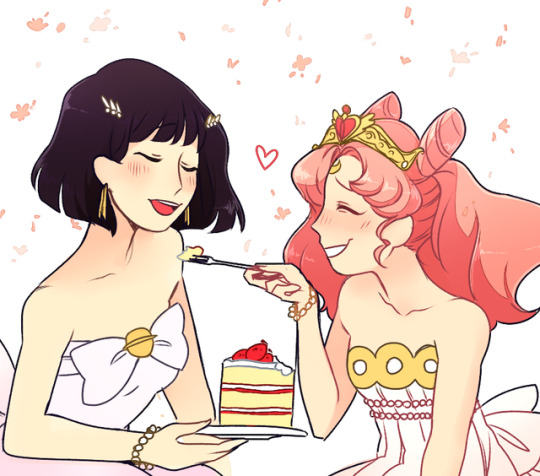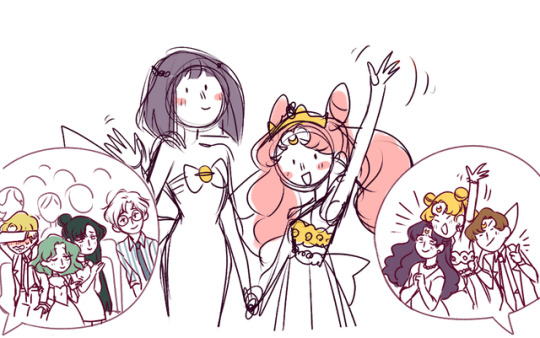Hello, my dear Yuri Lovers! Welcome to Shoujo Central, where we post and talk about yuri manga/anime! All are welcome 😊All are welcome 😊
Don't wanna be here? Send us removal request.
Text
Never forget the OG yuri goddesses 💛☀️🌙💙
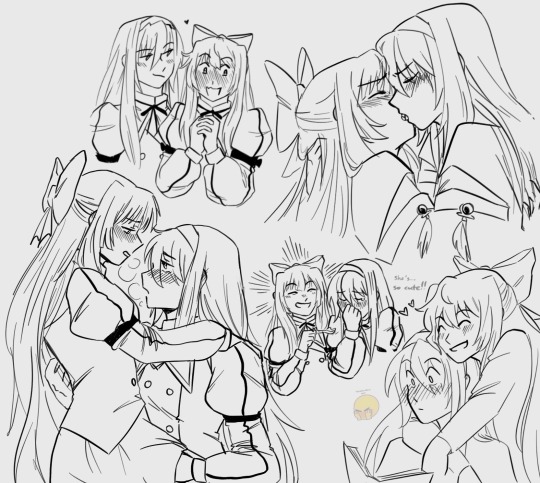
please for the love of yuri let someone remember Them
215 notes
·
View notes
Text

First Kiss - The Guy She Was Interested In Wasn't a Guy At All by Sumiko Arai
767 notes
·
View notes
Text
Viral Yuri Manga 'The Guy She Was Interested In Wasn't a Guy at All' Released in English
On Tuesday, Yen Press released the first volume of Sumiko Arai's popular Yuri manga The Guy She Was Interested In Wasn't a Guy at All (Ki ni Natteru Hito ga Otoko Janakatta) digitally and in paperback.

The manga, which started its weekly run on X (formerly Twitter) in 2022, follows gyaru Aya Oosawa, who develops a crush on the alt clerk at the CD shop she frequents, unaware that it is her female classmate, Mitsuki Koga. Yen Press further describes the series:
Fashionable and upbeat high schooler Aya falls head over heels for an employee at a local CD shop. He’s got an air of mystery about him, always dressed well, and has impeccable taste in music. Little does she know―this supposedly male employee is actually her female classmate Mitsuki! Mitsuki generally keeps to herself, but since her seat is right next to Aya’s, she can't help but be extremely aware of the other’s crush. Revealing the truth is out of the question―but perhaps getting closer to Aya wouldn’t be so bad...
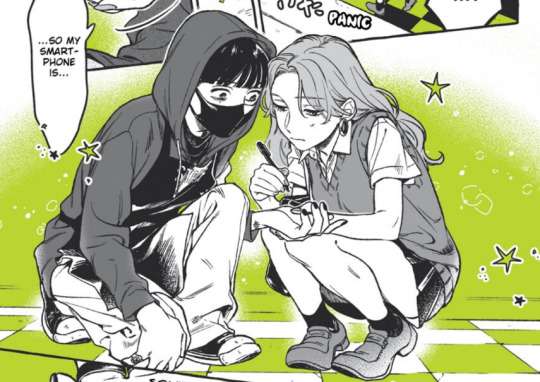
The series became incredibly popular after its release online, with fans internationally drawn in by the series' distinctive artwork, character designs, and green-color pallet. According to the English publisher, the manga was one of the most demanded series in the recent past and is set to become one of Yen Press's biggest releases of the year.
In April 2023, Kadokawa published the first volume of The Guy She Was Interested In in Japanese. The manga began serialization on Pixiv Comic the same month. The series also won Kadokawa's 2023 Next Manga Award in the web manga category. The second collected volume was released in Japanese in April and is scheduled for English release on February 18, 2025.

The series is translated into English by Ajani Oloye.
You can check out Volume One of The Guy She Was Interested In Wasn't a Guy at All in English digitally and in paperback: https://amzn.to/3YxI0kW
Edit: 10/24/24 - Corrected a character's name in the description.
7K notes
·
View notes
Text
Creators Crowdfund Butch Yuri Anthology 'Boyish²' on Campfire
Right now on Campfire, 10 Japanese creators are seeking crowdfunding for their new Yuri anthology Boyish². The all-ages doujinshi, which features relationships between "boyish" or butch characters, is scheduled for release at Comiket 99, this December.

According to the Campfire page, the doujin will also ship by mail order in December, even if Comiket is postponed or canceled. The doujinshi is seeking 400,000 JPY (approximately $3,650) for the project. If extra funds are collected, the organizers hope to use it to fund an English translation to be sold virtually. The English version would require between 200,000 to 300,000 JPY in addition to the 400,000 JPY goals.

Supporters have until September 24 to pledge for the series on Campfire at https://camp-fire.jp/projects/view/466971.
830 notes
·
View notes
Photo

Jo is a little insecure about her appearance but Alika is good at reassuring her.
31 notes
·
View notes
Text
LGBT+ Doujinshi Review - Silkscreen, by Isaki Uta

While I’m normally an avid fan of yuri and the Girl’s Love genre, over the past couple months I’ve decided to expand my horizons and take a look at other LGBT+ stories to see what they might have to offer. And that brings us to the doujinshi we’ll be looking at today, Isaki Uta’s Silkscreen.
For those who don’t know what a doujinshi is, they are essentially a self-published manga. Unlike manga that are serialized and published in a magazine or volume format, doujin are made, promoted and published by the authors and artists themselves.
Recently, the good folks over at Irodori Sakura reached out to me and asked me if I would be interested in providing a review for any of their LGBT+ manga titles. After getting over the joy of an official publisher giving me this opportunity, I accepted and they provided me with a copy of the doujin in exchange for an honest review. And honestly, I cannot thank them enough, because what I read ended up being one of my most pleasant surprises in recent memory.
Story and Characters
Silkscreen is a short story about a young lesbian girl who sees the world through a curtain. She loves drawing her idealized version of this unclear, blurry world and people around her. One of these people is a princely girl whom she falls deeply in love with, but when they one day reveal that they don’t identify as a girl, things go south very quickly. Years later, the two meet up again as adults, and seeing her old flame having begun to transition into a man, the girl must learn to push the silk screen curtain aside and accept the world for what it truly is.

In just forty pages, this story is delivered with perfect pacing and layered symbolism that is sure to stick in readers’ minds well after they’ve finished it. The short length leaves no room for fluff or filler in the best possible way; every story beat is important in establishing and exploring character, conflict, and themes. At its core, this is an exploration of selfish idealism and how such a worldview can be toxic and harmful to the people around you, especially those you love and care about.
This is all centered around a small cast of only two characters that, in a rather interesting choice, are given no names. While on the surface, this choice may confuse or even serve as a negative for some, it’s hardly noticeable while reading as the characters’ struggles are more than engaging enough to distract you from their lack of a name.
Our protagonist, the lesbian girl, is the focal point of the story’s themes, and is given the most depth and development. When we first meet her, she is a naïve young high schooler who loves drawing sketches and is head-over-heels for her “boyish girl” crush, eventually developing an intimate relationship with them. However, it’s not all sunshine and rainbows in her life, as she lives with a strict family who claims her chastity is her only value. Under such conditions, it’s understandable that she’d want, even demand, a prince to come along and rescue her from such a harsh environment. However, it’s this very selfish desire that ends up driving a wedge between her and her most precious person.
Years later, the girl is now a broken adult. She’s cut all ties with her parents, given up her passion for drawing in favor of printing the work of other designers, and has a very rocky relationship with her girlfriend who she gets jealous and possessive with. I won’t spoil where the story goes from here, as the climax is truly an emotional punch that should be experienced firsthand.

The deuteragonist is the genderqueer friend/trans man, who, while not nearly as emotionally complex, still gets a fair amount of growth. They serve as the realist in contrast to the lesbian’s romanticism, cutting off their relationship when they realize that she can’t love them for who they truly are and refusing to play a part in this girl’s fairy tale. While that’s all well and good, one minor issue that I have with the genderqueer’s character is how they claim to have truly loved the lesbian back when they were together, but the scenes of those days seem to suggest that they walked out of the relationship the moment the lesbian didn’t accept their true gender. It’s a real “blink and you’ll miss it” development, and I wish we saw at least one more scene of them struggling to maintain a relationship with the lesbian before finally breaking it off.

Presentation
Right out of the gate, Silkscreen grabs the reader’s eye with stunning artwork that, just like the writing, leaves no panel wasted. Make no mistake, while the cover art of the two leads seems basic or even underwhelming, it does not do justice to the content within. The character designs, while standard, are still beautifully detailed and fit the story’s elegant, mature tone. I especially love the subtle, yet noticeable changes to the characters between their teen and adult selves. The girl’s hair becomes more straight and frizzy, reflecting her loss of innocence and internal stress, and the genderqueer adopts slightly more masculine features due to being on testosterone for some time.
In numerous manga that I’ve read, especially ones that are serialized and thus run on a tight schedule, characters will often be placed against a blank background, making the world feel nonexistent at times. This is certainly not the case with Silkscreen. Isaki Uta has taken special care to make sure nearly every panel has something going on in it. Even ones that do feature blank backgrounds are used to communicate an emotion, like emptiness or depression. Shading and lighting are also utilized well, especially during dramatic moments. Despite the short length, the spectacle alone is enough to leave an emotional impact. This is clearly the work of a talented artist who understands the power of the visual medium.

Regarding the translation work done by Irodori Sakura’s team, it’s very solid. Translations were done by Itsuki, lettering by Tim Sun, formatting by CC Sū and Katarina Kunstelj, and quality assurance by On Takahashi and Zhuchka, and they’ve all done a fantastic job here. I came across no spelling or grammar mistakes, nor any sentences or word choices that felt off or distracting. The text was all perfectly formatted to fit their respective speech bubbles, and there were a couple instances of stylized text that emphasized the emotional punch of the characters speaking.
On all fronts, Silkscreen is pleasing to the eyes in terms of both style and readability.
LGBT+
While the LGBT+ themes mostly take a backseat to the character study, Isaki Uta has still managed to create a great deal of intrigue and overall great representation. While the concept of a lesbian dating someone who doesn’t identify as a woman might sound problematic on the surface, Uta works around this by having the girl be clear-cut sapphic. She views her high school sweetheart as a princely girl before they come out as genderqueer, even going so far as to compare them to some recognizable names like Oscar, Princess Sapphire and Haruka Tenoh, and has a new girlfriend once we transition to her adult life.

The genderqueer person/trans man was definitely a new experience for me as a manga reader, as genderfluid characters are not often represented seriously in media that I’ve been exposed to. The author’s note at the end describes them as someone who is “attracted to women” and “mostly identifies as a man but is a nonbinary individual that jumps back and forth between the two binary genders.” While I haven’t read any of Isaki Uta’s other works, she is apparently known for leaving parts of her stories ambiguous and up to the reader’s interpretation, which is something I personally enjoy a lot. The vagueness, or perhaps the more appropriate term would be fluidity, of the genderqueer’s identity seems to be written to starkly contrast the image the lesbian had of them and to emphasize how closed-minded she is throughout most of the story.

However, where Silkscreen stumbles in terms of its LGBT+ content is not in the story, but the marketing. Irodori Sakura has the story tagged on their website as LGBTQ+, Trans Identity, and Yuri. Irodori has gone on record to say that their works involve the original author in the localization process, and all works receive the final approval of the author before it is made available for sale. According to both Irodori’s website and the author’s note at the end of the doujin, Isaki Uta classifies the story as “Yuri” and the tag was added as such to stay true to their vision. To quote Uta, ���At least for me, the work is pure yuri. In my opinion, if there’s even a glimpse of light, the love is there, no matter how it changes form later on.”
I’m a cis guy, so I’ll refrain from injecting my opinion about this, but the takeaway here seems to be that since the genderqueer’s identity is somewhat fluid, the portion of the story that covers their relationship before they came out as not female could be interpreted as yuri. However, therein lies a problem. Claiming something is open to interpretation, only to give it a defining label comes across as hypocritical, even if unintentionally. While there are undoubtedly cultural differences at play here, this could risk putting off and possibly even offending some readers who view the genderqueer’s identity differently. It doesn’t exactly hurt the overall representation, but it’s still something readers should be aware of before going into the story.

Closing Thoughts
Silkscreen’s minimal shortcomings do little, if anything at all, to hurt its overall quality. It accomplishes exactly what it sets out to do: tell a quick, yet engaging and bittersweet story with gorgeous visuals and compelling characters, capped off with a deeply human message about letting go of naïve and self-destructive idealism. While it may suffer from a few underdeveloped plot points and questionable aspects to its LGBT+ content, those issues can be boiled down to the length and marketing respectively, rather than the story itself. The team over at Irodori Sakura has done Western manga consumers a great favor by bringing over another of Isaki Uta’s wonderful works and getting her the recognition she deserves. I, for one, will be checking out more unique and diverse LGBT+ stories if it means I can come across more gems such as this one, and perhaps Silkscreen will inspire you to do the same.
Rating: 9/10
Purchase Silkscreen: https://irodorilite.com/products/silkscreen?utm_medium=partner&utm_source=review&utm_campaign=gm
39 notes
·
View notes
Text
LGBT+ Doujinshi Review - Silkscreen, by Isaki Uta

While I’m normally an avid fan of yuri and the Girl’s Love genre, over the past couple months I’ve decided to expand my horizons and take a look at other LGBT+ stories to see what they might have to offer. And that brings us to the doujinshi we’ll be looking at today, Isaki Uta’s Silkscreen.
For those who don’t know what a doujinshi is, they are essentially a self-published manga. Unlike manga that are serialized and published in a magazine or volume format, doujin are made, promoted and published by the authors and artists themselves.
Recently, the good folks over at Irodori Sakura reached out to me and asked me if I would be interested in providing a review for any of their LGBT+ manga titles. After getting over the joy of an official publisher giving me this opportunity, I accepted and they provided me with a copy of the doujin in exchange for an honest review. And honestly, I cannot thank them enough, because what I read ended up being one of my most pleasant surprises in recent memory.
Story and Characters
Silkscreen is a short story about a young lesbian girl who sees the world through a curtain. She loves drawing her idealized version of this unclear, blurry world and people around her. One of these people is a princely girl whom she falls deeply in love with, but when they one day reveal that they don’t identify as a girl, things go south very quickly. Years later, the two meet up again as adults, and seeing her old flame having begun to transition into a man, the girl must learn to push the silk screen curtain aside and accept the world for what it truly is.

In just forty pages, this story is delivered with perfect pacing and layered symbolism that is sure to stick in readers’ minds well after they’ve finished it. The short length leaves no room for fluff or filler in the best possible way; every story beat is important in establishing and exploring character, conflict, and themes. At its core, this is an exploration of selfish idealism and how such a worldview can be toxic and harmful to the people around you, especially those you love and care about.
This is all centered around a small cast of only two characters that, in a rather interesting choice, are given no names. While on the surface, this choice may confuse or even serve as a negative for some, it’s hardly noticeable while reading as the characters’ struggles are more than engaging enough to distract you from their lack of a name.
Our protagonist, the lesbian girl, is the focal point of the story’s themes, and is given the most depth and development. When we first meet her, she is a naïve young high schooler who loves drawing sketches and is head-over-heels for her “boyish girl” crush, eventually developing an intimate relationship with them. However, it’s not all sunshine and rainbows in her life, as she lives with a strict family who claims her chastity is her only value. Under such conditions, it’s understandable that she’d want, even demand, a prince to come along and rescue her from such a harsh environment. However, it’s this very selfish desire that ends up driving a wedge between her and her most precious person.
Years later, the girl is now a broken adult. She’s cut all ties with her parents, given up her passion for drawing in favor of printing the work of other designers, and has a very rocky relationship with her girlfriend who she gets jealous and possessive with. I won’t spoil where the story goes from here, as the climax is truly an emotional punch that should be experienced firsthand.

The deuteragonist is the genderqueer friend/trans man, who, while not nearly as emotionally complex, still gets a fair amount of growth. They serve as the realist in contrast to the lesbian’s romanticism, cutting off their relationship when they realize that she can’t love them for who they truly are and refusing to play a part in this girl’s fairy tale. While that’s all well and good, one minor issue that I have with the genderqueer’s character is how they claim to have truly loved the lesbian back when they were together, but the scenes of those days seem to suggest that they walked out of the relationship the moment the lesbian didn’t accept their true gender. It’s a real “blink and you’ll miss it” development, and I wish we saw at least one more scene of them struggling to maintain a relationship with the lesbian before finally breaking it off.

Presentation
Right out of the gate, Silkscreen grabs the reader’s eye with stunning artwork that, just like the writing, leaves no panel wasted. Make no mistake, while the cover art of the two leads seems basic or even underwhelming, it does not do justice to the content within. The character designs, while standard, are still beautifully detailed and fit the story’s elegant, mature tone. I especially love the subtle, yet noticeable changes to the characters between their teen and adult selves. The girl’s hair becomes more straight and frizzy, reflecting her loss of innocence and internal stress, and the genderqueer adopts slightly more masculine features due to being on testosterone for some time.
In numerous manga that I’ve read, especially ones that are serialized and thus run on a tight schedule, characters will often be placed against a blank background, making the world feel nonexistent at times. This is certainly not the case with Silkscreen. Isaki Uta has taken special care to make sure nearly every panel has something going on in it. Even ones that do feature blank backgrounds are used to communicate an emotion, like emptiness or depression. Shading and lighting are also utilized well, especially during dramatic moments. Despite the short length, the spectacle alone is enough to leave an emotional impact. This is clearly the work of a talented artist who understands the power of the visual medium.

Regarding the translation work done by Irodori Sakura’s team, it’s very solid. Translations were done by Itsuki, lettering by Tim Sun, formatting by CC Sū and Katarina Kunstelj, and quality assurance by On Takahashi and Zhuchka, and they’ve all done a fantastic job here. I came across no spelling or grammar mistakes, nor any sentences or word choices that felt off or distracting. The text was all perfectly formatted to fit their respective speech bubbles, and there were a couple instances of stylized text that emphasized the emotional punch of the characters speaking.
On all fronts, Silkscreen is pleasing to the eyes in terms of both style and readability.
LGBT+
While the LGBT+ themes mostly take a backseat to the character study, Isaki Uta has still managed to create a great deal of intrigue and overall great representation. While the concept of a lesbian dating someone who doesn’t identify as a woman might sound problematic on the surface, Uta works around this by having the girl be clear-cut sapphic. She views her high school sweetheart as a princely girl before they come out as genderqueer, even going so far as to compare them to some recognizable names like Oscar, Princess Sapphire and Haruka Tenoh, and has a new girlfriend once we transition to her adult life.

The genderqueer person/trans man was definitely a new experience for me as a manga reader, as genderfluid characters are not often represented seriously in media that I’ve been exposed to. The author’s note at the end describes them as someone who is “attracted to women” and “mostly identifies as a man but is a nonbinary individual that jumps back and forth between the two binary genders.” While I haven’t read any of Isaki Uta’s other works, she is apparently known for leaving parts of her stories ambiguous and up to the reader’s interpretation, which is something I personally enjoy a lot. The vagueness, or perhaps the more appropriate term would be fluidity, of the genderqueer’s identity seems to be written to starkly contrast the image the lesbian had of them and to emphasize how closed-minded she is throughout most of the story.

However, where Silkscreen stumbles in terms of its LGBT+ content is not in the story, but the marketing. Irodori Sakura has the story tagged on their website as LGBTQ+, Trans Identity, and Yuri. Irodori has gone on record to say that their works involve the original author in the localization process, and all works receive the final approval of the author before it is made available for sale. According to both Irodori’s website and the author’s note at the end of the doujin, Isaki Uta classifies the story as “Yuri” and the tag was added as such to stay true to their vision. To quote Uta, “At least for me, the work is pure yuri. In my opinion, if there’s even a glimpse of light, the love is there, no matter how it changes form later on.”
I’m a cis guy, so I’ll refrain from injecting my opinion about this, but the takeaway here seems to be that since the genderqueer’s identity is somewhat fluid, the portion of the story that covers their relationship before they came out as not female could be interpreted as yuri. However, therein lies a problem. Claiming something is open to interpretation, only to give it a defining label comes across as hypocritical, even if unintentionally. While there are undoubtedly cultural differences at play here, this could risk putting off and possibly even offending some readers who view the genderqueer’s identity differently. It doesn’t exactly hurt the overall representation, but it’s still something readers should be aware of before going into the story.

Closing Thoughts
Silkscreen’s minimal shortcomings do little, if anything at all, to hurt its overall quality. It accomplishes exactly what it sets out to do: tell a quick, yet engaging and bittersweet story with gorgeous visuals and compelling characters, capped off with a deeply human message about letting go of naïve and self-destructive idealism. While it may suffer from a few underdeveloped plot points and questionable aspects to its LGBT+ content, those issues can be boiled down to the length and marketing respectively, rather than the story itself. The team over at Irodori Sakura has done Western manga consumers a great favor by bringing over another of Isaki Uta’s wonderful works and getting her the recognition she deserves. I, for one, will be checking out more unique and diverse LGBT+ stories if it means I can come across more gems such as this one, and perhaps Silkscreen will inspire you to do the same.
Rating: 9/10
Purchase Silkscreen: https://irodorilite.com/products/silkscreen?utm_medium=partner&utm_source=review&utm_campaign=gm
#lgbt#lgbt+#gay#lesbian#trans#transgender#transmasc#non binary#genderqueer#genderfluid#manga#lgbt manga#doujinshi#doujin#comics#silkscreen#irodori#reviews
39 notes
·
View notes
Text
Awaken in a Full Yuri World in Newly Released Yuri Manga 'The Whole of Humanity Has Gone Yuri Except Me'
On July 20, Yen Press released its English edition of Hiroki Haruse's comedy Yuri series The Whole of Humanity Has Gone Yuri Except Me (Watashi Igai Jinrui Zenin Yuri). The single-volume English edition contains the entire series, originally published in Japanese in two volumes.

The publisher describes the manga:
Marika Uruuno is just a normal girl in a normal world. She’ll fall in love normally, get married normally, and have a normal family— or that was the plan anyway. But when she suddenly wakes up in a version of reality filled only with women, she finds herself questioning what exactly “normal” means and why it’s so important to her. And as Mariko discovers something even more precious, she’s faced with a choice—will she find a way back to her previous life…or will she stay in this strange new world?
The manga was serialized in Shounen Ace Plus until its conclusion last year. Two volumes are published in Japanese by Kadokawa. The entire series is bound in the single-volume English omnibus release.
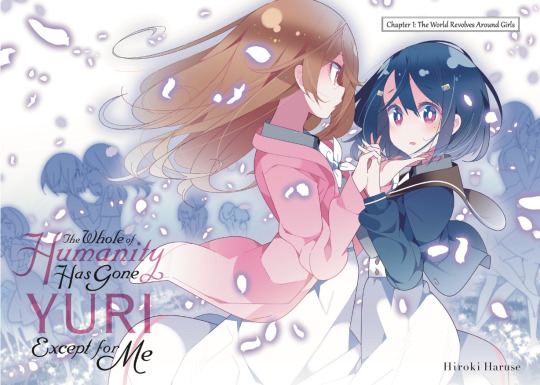
The Whole of Humanity Has Gone Yuri Except Me is available now digitally and in English paperback: https://amzn.to/3kL2gMy
Reading official releases helps support creators and publishers. YuriMother makes a small affiliate commission from sales to help fund future coverage.
159 notes
·
View notes
Photo


just remembered this hc and started crying
//continued from this n this
3K notes
·
View notes
Note
So i really do love your art, i have asked you to do this like two times before, but could you please do a Hotaru and Chibiusa fanart?

they do their best
894 notes
·
View notes
Photo

✿.。.:* ♀ *.:。✿。:.* ♀ *.。.✿ Created By:||☆TaaRO☆ respective credits to the creator ✿.。.:* ♀ *.:。✿。:.* ♀ *.。.✿ ⓟⒶⓇⒶⒹⒾⓈⒺ♡ⓎⓊⓇⒾ
762 notes
·
View notes









